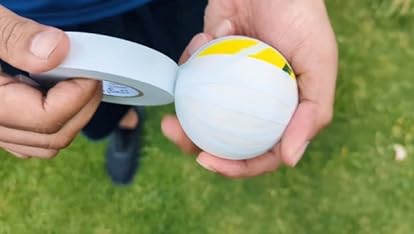How to tape a tennis ball for cricket 2025
Guide to how to tape a tennis ball for cricket
Tennis ball cricket has become popular street cricket, providing players with a fun, fast-paced version of the traditional game. Using a tennis ball in cricket can make the game more accessible, especially in informal settings where a proper cricket ball isn’t available. However, if you want to increase the performance of your tennis ball—particularly for bowling or hitting with greater precision—taping the ball is a commonly used technique.
When a tennis ball is taped, it behaves much more like an absolute cricket ball, allowing players to impart spin, bounce, and swing more easily. If you want to learn how to tape a tennis ball for cricket. This article provides a step-by-step guide to ensure you get the most out of your tennis ball cricket experience.

Why Tape a Tennis Ball for Cricket?
Taping a tennis ball for cricket has multiple benefits. Unlike an untaped tennis ball, a taped ball moves differently, mimicking the flight and behavior of an absolute cricket ball. The tape adds weight and texture to the ball, making it harder to hit and more effortless to bowl with various deliveries like spin, bounce, and swing. Here are a few reasons why players tape their tennis balls:
- Increased Swing and Bounce – Taping the ball helps it swing more in the air and bounce more consistently off the surface.
- Better Grip for Spinners—The tape allows spinners to get a better grip on the ball, making it easier to turn it.
- Improved Durability – A taped tennis ball lasts longer, mainly in rougher conditions like complex grounds or gravel pitches.
- More Realistic Play – Taping the ball mimics the flight of an absolute cricket ball, adding realism to your street or backyard cricket games.
Materials Needed to Tape a Tennis Ball
Before we dive into the steps of taping a tennis ball, let’s gather the necessary materials. The process is simple, and you likely already have these items at home:
- A Tennis Ball – Choose a standard tennis ball for taping. Opt for a high-quality one with a good bounce for better performance.
- Osaka Tape or Electrical Tape – Osaka tape is famous and most usable tape due to its ability to stick firmly. However, electrical tape can also be used if you want something thinner.
- Scissors – Cut the tape to the correct size and shape.
- A Sharp Knife (optional) is recommended if you want to add a more custom or precise design to the tape.
Step-by-Step Guide: How to Tape a Tennis Ball for Cricket
Now that we have everything ready, let’s go through the steps to tape a tennis ball for cricket.
- Choose the Right Tennis Ball
Begin by deciding on a good-quality tennis ball. Equally important, make sure to pick one that is still in its early stages and that has been worn out as it may affect the way the performance is taped. A new tennis ball will provide a better taping and bounce performance which will enhance your overall tape performance.
- Cut the Tape
Take a piece of duct tape (about 6-8 inches long) and cut it neatly. You can experiment with the width of the tape based on your preferences, but a medium width works best for balance.
- Wrap the Tape Around the Ball
Start at one end of the tennis ball and begin wrapping the tape around it. Make sure you cover one-half of the ball completely, as this is where most of the grip and movement will come from. Apply the tape firmly to avoid any air bubbles or loose spots. The goal is to wrap it tightly enough to stay in place but not so tight that it causes the ball to lose shape.
- Overlap the Tape
As you wrap the tape, make sure to slightly overlap each layer. This creates extra thickness and ensures the tape stays in place. Keep the tape even to maintain a balanced feel when holding the ball. Some players prefer to create a spiral-like pattern with the tape, which can affect the ball’s aerodynamics, making it move more in the air.
- Cover the Entire Half of the Ball
Cover the entire half of the tennis ball when wrapping, leaving the other half untaped. This allow you to maintain the bounce of the tennis ball on the untaped side while gaining the advantages of the taped side. A completely taped ball can sometimes behave unpredictably, so leaving half the ball untaped gives you the best of both worlds.
- Trim the Edges
Once the ball is properly taped, use the scissors to trim any excess tape around the edges. Ensure the tape is flush with the ball and has no loose ends that can unravel during play. If there are any uneven parts, carefully smooth them out so the tape stays in place.
- Test the Ball
After taping the ball, could you give it a test run? Drop it on the ground to see if it bounces correctly and check how it behaves when thrown or bowled. The taped part should cause the ball to move in the air, allowing for swing or spin. If you feel the ball is too heavy or too light, you can adjust the amount of tape used.
Tips for Taping a Tennis Ball for Cricket
- Don’t Overdo the Tape—While it’s tempting to wrap the ball with many layers of tape for maximum effect, too much tape can make the ball too heavy and reduce its bounce. One or two layers are usually enough to enhance its performance.
- Experiment with Designs – Try different patterns or designs with the tape. Some players use spiral wraps or cross patterns to increase the ball’s spin potential. Experiment to see what works best for you.
- Use Quality Tape – Not all tapes are created equal. Duct tape is generally the best choice because it is sticky and durable. Other types of tape, like masking tape, may also not hold up during long sessions.
- Change Tape as Needed—Over time, the tape will start to wear off, especially after heavy use. If it begins to peel or lose its grip, it’s time to re-tape the ball.
How Taping a Tennis Ball Affects Bowling and Batting
When you tape a tennis ball, it doesn’t just affect how the ball is bowled; it also changes how the batter plays. Here’s how:
- Bowling – Bowlers will notice a significant improvement in the swing and bounce of the taped ball. Fast bowlers will benefit from extra pace and bounce, while spinners will find it easier to impart turn on the ball.
- Batting—A taped tennis ball behaves differently for the batsman, making it harder to hit cleanly. The ball’s movement in the air and off the surface adds an extra layer of challenge, and players must adjust their shots accordingly.
Why Not Use a Cricket Ball?
While using a cricket ball for practice is always ideal, many players turn to taped tennis balls because they are easier to get and less expensive. Tape ball cricket allows players to enjoy the game without expensive equipment, and playing in informal settings is safer. Tapping the tennis ball bridges the gap between traditional and street cricket, making it a versatile tool for practice.
FAQs
- Can I use other types of tape besides duct tape?
- While duct tape is most commonly used, electrical tape or even masking tape can be used. However, duct tape tends to be the most durable and effective.
- Does the tape affect the bounce of the ball?
- Yes, taping the ball can reduce its natural bounce, but it increases its movement in the air, allowing for more swing and spin.
- How much tape should I use on the tennis ball?
- Typically, one or two layers of tape are enough. Adding too many layers can make the ball lighter.
- Can I tape both halves of the ball?
- You can, but it’s generally not recommended as it may cause the ball to behave unpredictably. Taping one half is sufficient for the benefits you want.
- How often should I change the tape?
- After significant use, the tape will begin to wear out. It’s best to change it when it starts to peel or lose its grip.
- How does taping a tennis ball improve spin?
- The extra grip provided by the tape allows bowlers, especially spinners, to better hold the ball, helping them generate more turns.
Conclusion
Taping a tennis ball for cricket is a simple yet effective way to enhance your street or backyard cricket experience. with experience and technique you can move the ball that moves more like a professional cricket ball, providing better bounce, swing, and spin. Whether you’re a bowler looking to add extra spin or a batter trying to sharpen your skills against a trickier delivery, taping your tennis ball is a great way to improve your game. Now, with these simple steps and tips, you can make the most of your next cricket session!





